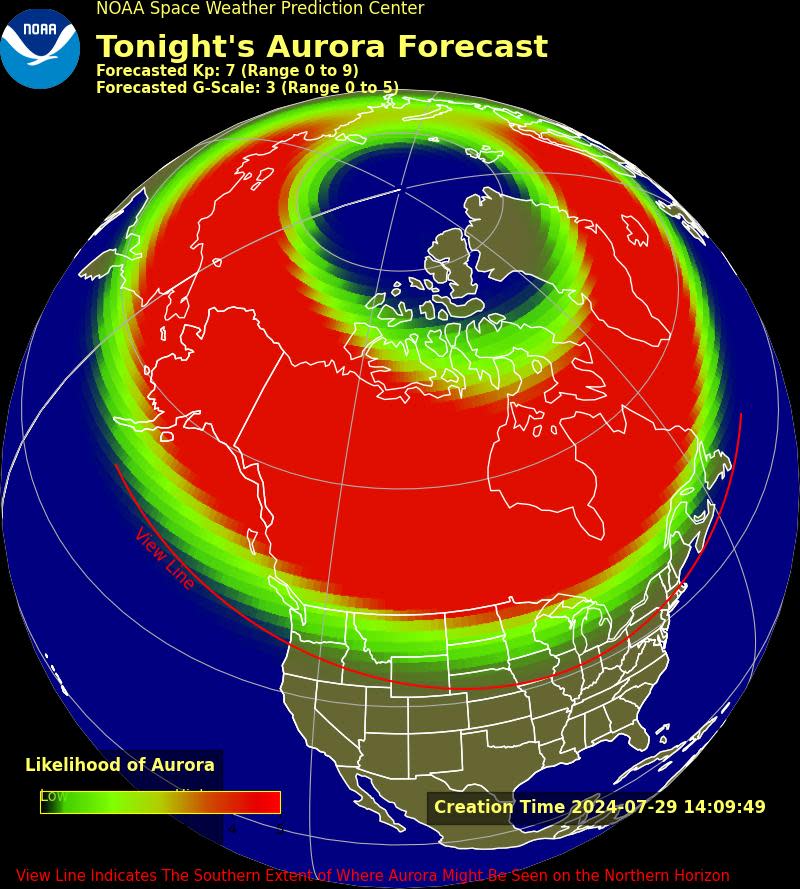Grab a comfy chair and head outside for multiple meteor showers. Where to watch in Florida
Tonight and the next couple of nights will be especially good times to head outside to see three meteor showers taking place around the same time.
Also appearing in the night sky will be the northern lights, although they aren't expected to be visible in Florida like they were on May 10.
On the bright side — or should we say dark side — the waning moon should provide good views of two of the three meteor showers .... weather permitting, of course.
Here's what is happening in the night sky:
Southern Delta Aquariids peak July 29-30
The Southern Delta Aquariid meteors will appear near the constellation Aquarius in the southern sky.
In the Northern Hemisphere, look to the south to spot the meteors. The predicted peak will be on the nights of July 29 through July 30. The shower began July 18 and will run through early Aug. 21.
The Southern Delta Aquariid meteors coincide with the start of the Perseids meteor shower.
The radiant is the point in the sky where the paths of meteors seem to originate.
Fast facts provided by NASA and EarthSky.org
Comet of origin: Unknown, but 96P Machholz suspected
Radiant: Constellation Aquarius
Active: July 18-Aug. 21
When to watch: Late July through early August, mid-evening to dawn.
Expected number of meteors at peak: maximum hourly rate can reach 15 to 20 meteors an hour.
Perseid meteor shower started July 14; peak time coming in August
Also considered a major meteor shower, the Perseids started July 14 and will continue to Sept. 1. The most activity is expected Aug. 11-13.
The Perseids will radiate near the constellation Perseus in the Northern Hemisphere.
The Perseid meteor shower is known for frequent and plentiful meteors, up to 90 an hour.
Fast facts provided by EarthSky.org
Comet of origin: 109P/Swift-Tuttle.
Radiant: constellation Perseus. The radiant rises in the middle of the night and is highest at dawn.
Active: July 14-Sept. 1
When to watch: best time to watch for Perseids will be starting around midnight until dawn.
Peak: Aug. 12
Expected number of meteors at peak: 90 meteors per hour, or more. meteors are colorful. And they frequently leave persistent trains.
Is it a Perseid or Delta Aquariid meteor?
How can you tell the difference?
If you’re in the Northern Hemisphere and it's after midnight or after, EarthSky said:
Alpha Capricornids meteor shower also appearing in night sky
Considered a minor meteor shower, the Alpha Capricornids is active until Aug. 15.
The Alpha Capricornids rarely produce more than five meteors an hour but is taking place the same time as the southern Delta Aquarids and the Perseids.
"This shower is not very strong and rarely produces in excess of five shower members per hour," the American Meteor Society said. "What is notable about this shower is the number of bright fireballs produced during its activity period."
Fast facts provided by InTheSky.org.
Comet of origin: comet 169P/NEAT
Radiant: constellation Capricornus
Active: July 7-Aug. 15
When to watch: from midnight to dawn
Peak: July 30
Expected number of meteors at peak: 5 meteors per hour, according to InTheSky.org.
Solar flare making northern lights visible in some parts of US

National Oceanic and Atmospheric Space Weather Prediction Center has issued a geomagnetic storm warning for July 30, although the exact timing is uncertain. During these storms, ions interacting with gases in Earth's atmosphere, release energy as light commonly known as the northern lights, or aurora borealis, in the Northern Hemisphere, according to Space.com.
The northern lights may be visible over many northern states and some of the lower Midwest to Oregon, NOAA's Space Weather Prediction Center said.
This article originally appeared on Treasure Coast Newspapers: Delta Aquariid, Perseids, Capricornids meteor showers visible over FL

